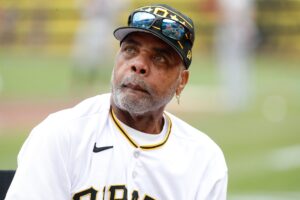In the 1940s, the world went to war with itself for the second time. Shots were fired, and bombs fell as The Allies and The Axis did battle. This had a profound impact on the Major Leagues. The war years saw multiple superstars head off to serve the country. Ted Williams and Joe DiMaggio were among the biggest names. Domestically, in 1947, Jackie Robinson broke the color barrier in the game by signing with the Brooklyn Dodgers. In short, baseball underwent a lot of significant changes in this historic decade.
For the Boston Bees, the span was something of a volcano. They began at the bottom, then slowly started rising to the top. Midway through, they began to form lava-like effects. The bum years were put behind them. In small steps, they tunneled their way through the league. The World Series was the destination of this smoldering stream. But the rumbling began with two pitchers: Warren Spahn and Johnny Sain.
1940s Boston Bees/Braves:
An Attempt at the Future
In 1940, the Bees were attempting to put a dreadful decade behind them. Unfortunately, they could not. Casey Stengel’s second year yielded a 65-87 record. The offense was terrible, though there was a bright spot. Outfielder Chet Ross led the team with a 129 OPS+, 17 homers, 89 RBI, and 160 hits. The pitching continued to suffer, though there were bright spots here as well. Jim Tobin went 7-3 with a 3.83 ERA in 11 starts. Right-hander Manny Salvo was the only starter to finish above .500 (10-9, 3.08 ERA, 119 ERA+). But the bullpen was atrocious, with most relievers posting an ERA in the mid fives. The team ERA of 4.36 was sixth in the league.
After being permanently renamed the Braves in 1941, they went 62-92. Ross had left the team, so the offense took a bit of a tumble. But outfielder Max West picked up the slack (.277 average, 12 homers, 68 RBI, 130 OPS+). The pitching improved to a 3.95 ERA, but that’s not saying a lot. Tobin was the ace, going 12-12 with a 3.10 ERA and a 114 ERA+. Everyone else was somewhere between mediocre and terrible. Salvo fell to seven wins, and righty Dick Errickson was 6-12.
More Woes
1942 saw even more misery enter Boston’s clubhouse. A 59-89 mark planted them seventh in the league. Not even the presence of Hall of Famer Ernie Lombardi could change the team’s fortunes. He did win the batting title with a .330 average. But that was all that could be said for the offense. The team finished with a collective .240 average and an OPS+ of 88. The pitching staff hung around their previous performance with a 3.76 ERA. Salvo won seven games again, but his ERA+ of 110 led the team. The year did bear witness to Spahn’s debut. But after just four games in the big leagues, he’d be plucked for three years of military service.
In 1943, the Braves improved to 68-85. However, midway through the season, Stengel was ousted as manager. Bob Coleman took his spot for the final 46 games. But other than that, the season was business as usual. The offense hit a whopping .233. The only bright spot was first baseman Johnny McCarthy (.304 average, 95 hits, 122 OPS+ in 78 games). However, the pitching continued to improve. The team jumped to fourth in the league in ERA (3.25). They also posted an ERA+ of 105. Al Javery led the rotation with 17 wins. Counterpart Nate Andrews racked up a 2.57 ERA and a 131 ERA+ despite going 14-20. Meanwhile, Jim Tobin continued to be consistent (14-14, 2.66 ERA, 127 ERA+).
Two Bad Seasons and Two Good Ones
As the war raged on elsewhere, the Braves barely hung on at home. 1944 was lackluster, with a 65-89 record. Outfielder Tommy Holmes was a major offensive bright spot (.309 average, 195 hits, 42 doubles, 128 OPS+). However, the pitching continued to burn a fuel of indifference. The ERAs remained in the mid-3s, despite Tobin having a career year. He won 18 games with a 3.01 ERA and 28 complete games. His ERA+ of 127 led the team. But it wasn’t enough to pull the staff out of the fire. 1945 was about the same, with Coleman being ousted after 93 games. He was replaced by Del Bissonette. All in all, the team finished 67-85.
Then came a three year period of massive success. The war had ended, and many of the team’s key players returned. In 1946, Billy Southworth began his tenure as manager, and the team finished 81-72. Holmes continued leading the offense, which rebounded significantly. But the real change came in the pitching. Spahn and Sain were back, with the latter winning 20 games. They both posted ERAs under three. In short, the volcano was beginning to erupt.
1947 saw the flames begin to burst as the team went 86-68. The offense was one of the best in the league. Rookie third baseman Bob Elliott led the team (.317/.410/.517, 22 homers, 113 RBI, 176 hits, 147 OPS+). Along with contributions from Holmes, Phil Masi, and Earl Torgeson, the team managed a .275 average. Meanwhile, Spahn and Sain both won 20 games. However, Spahn was the undoubted ace (21-10, 2.33 ERA, 170 ERA+).
World Series Bound!
Things really boiled over in 1948. The Braves went 91-62. The long 34-year drought was over. Boston was back in the World Series. Once again, the combination of a terrific offense and balanced pitching carried the team. This year, it was Elliott, Holmes, and outfielder Jeff Heath who kept the offense running. Meanwhile, Sain won 24 games, posted a 2.60 ERA, and a 149 ERA+. Spahn went 15-12, with a 3.71 ERA and a 105 ERA+. They were joined by rookie Vern Bickford (11-5, 3.27 ERA, 119 ERA+) and veteran righty Bill Voiselle (13-13, 3.63 ERA, 107 ERA+). Sadly, the team lost the Fall Classic. But, for one shining moment, the Braves were back on top.
A Massive Fall for the Braves
The team tumbled at the end of the decade, finishing 75-79. In a somewhat confusing decision, they fired Southworth after a respectable 55-54 start. They replaced him with Johnny Cooney, who went 20-25. The offense fell from first to sixth in average. Elliott continued booming, posting 17 homers and a 135 OPS+. Everyone else was somewhere from mediocre to passable. But it was the pitching that truly created leaks. While Spahn won 21 more games, Sain fell to 10 wins. The team went from first to fifth in ERA, with an ERA+ of 96. They finished fourth, 22 games behind the Dodgers.
Main Photo:
Embed from Getty Images






